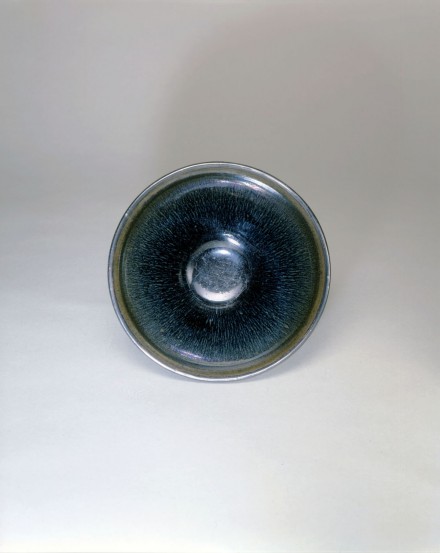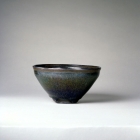J.J. Lally & Co., Oriental Art / New York City, New York
MenuPast Exhibition
Chinese Ceramics A.D. 400–1400:
Selections from an American Collection
March 19 - 31, 2007

13.
A JIANYAO ‘HARE’S FUR’ GLAZED TEABOWL (YANKOU WAN)
Song Dynasty, A.D. 12th-13th Century
with a lustrous very dark brown-black glaze suffused with fine silvery-brown slightly iridescent ‘hare’s fur’ streaks showing an undercurrent of lavender, the markings converging towards the center on the interior and cascading from the lip on the exterior, the heavily potted flaring sides rising from a small circular foot with very shallow footrim, the wide mouth with a narrow ‘finger-groove’ lightly indented on the exterior below the tapered vertical lip now edged with a silver mount, the glaze on the exterior collecting in a thick roll at a knife-pared angle just above the base and gathering into two droplets at the edge, the exposed foot showing the coarse iron-rich body clay burnt to a dark purplish-brown color in the firing.
Diameter 5 1⁄8 inches (12.9 cm)
From the Collection of J. Hellner, Stockholm
Published
by Gyllensvärd, Kinesisk Keramik, Stockholm, 1948, no. 31
by Gyllenvärd, Oriental Ceramics: The World’s Great Collections, Vol. 8, The Museum of Far Eastern Antiquities, Stockholm, Tokyo, 1982, fig. 152
Exhibited
by Dubosc, Mostra d’Arte Cinese: Settimo Centenario di Marco Polo (Exhibition of Chinese Art: The Seventh Centenary of Marco Polo), Venice, 1954, p. 139, no. 495
by Gyllensvärd, Kina och Norden I form och glasyr ur Hellnerska samlingen (Chinese and Scandinavian Ceramics A Selection from the Hellner Collection), Museum of Far Eastern Antiquities, Stockholm, 1970, no. 29, p. 59
by Mowry, Hare’s Fur, Tortoiseshell and Partridge Feathers: Chinese Brown-and Black-Glazed Ceramics, 400-1400, Cambridge, 1996, no. 82, pp. 218-219
by Poster, Crosscurrents: Masterpieces of East Asian Art from New York Private Collections, Japan Society, New York, 1999, no. 44, pp. 132-133
A Jianyao ‘hare’s fur’ glazed teabowl of this classic form, also with a silver mount on the rim, in the Percival David Foundation, London, is illustrated by Pierson, Song Ceramics: Objects of Admiration, London, 2003, no. 12, pp. 44-45; and the same bowl is illustrated by Medley, The Chinese Potter, Oxford, 1976, fig. 123, p. 163.
Another Jianyao ‘hare’s fur’ glazed teabowl with silver-mounted rim is illustrated by Wu, Earth Transformed: Chinese Ceramics in the Museum of Fine Arts, Boston, Boston, 2001, pp. 72-73, where the author states that this type of teabowl was favored by the emperor Huizong (r. 1101-1125), who was a great connoisseur of tea and wrote famous treatises on the subject. In the opinion of emperor Huizong and other tea connoisseurs of the period, the dark ‘hare’s fur’ glazed teabowls from the kilns in Fujian province were particularly pleasing when used for drinking the frothy light-green tea preferred in the Song period.
Additional Images (Touch to enlarge)
13.
A JIANYAO ‘HARE’S FUR’ GLAZED TEABOWL (YANKOU WAN)
Song Dynasty, A.D. 12th-13th Century
Diameter 5 1⁄8 inches (12.9 cm)
